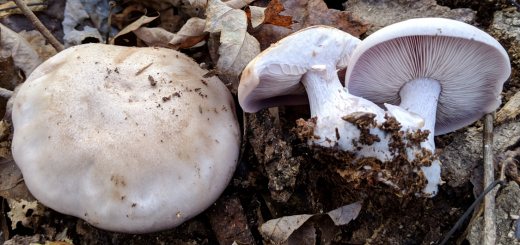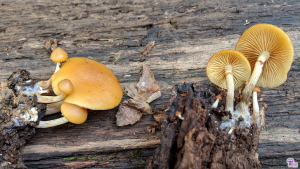#056: Artomyces pyxidatus, The Crown-Tipped Coral Fungus
This beautiful coral mushroom is easily distinguished by its distinctive tips. The tip of each branch sports a number of small points that surround a bowl-like, central depression. It is this crown-like arrangement that earned the Crown-Tipped Coral its common name. No other coral fungi in North America have this distinctive crown pattern, so pyxidatus is easy to identify. The fruiting body is a medium-sized to large, branching structure, like other coral fungi. Each branch develops from one of the tips at the end of another branch. Older branches at the base of the mushroom are thicker to support the rest of the structure. The coral fungus varies in color from white to yellowish to tan, with the newly-formed branches at the top lighter than the old branches at the base.
Unlike most coral fungi, the Crown-Tipped Coral decomposes dead wood and can be found fruiting directly from hardwood logs from spring through fall. In North America, it is most often encountered east of the Rocky Mountains. Sometimes this mushroom forms numerous, small mushrooms from the same log, but it may produce only one, large mushroom. A. pyxidatus is edible, but must be cooked beforehand. If you taste a fresh specimen (without swallowing), you will find that it develops a peppery flavor. That flavor usually disappears upon cooking, but you may find that a faint hint remains.
A. pyxidatus has been the focus of a number of genetic studies, so we know quite a bit about its global relationships. Mating studies have shown that A. pyxidatus individuals from Asia, Europe, and North America can all successfully reproduce with one another. For now, this means that all populations of A. pyxidatus represent the same species. However, studies of genetic markers suggest that there there are three genetically distinct groups of A. pyxidatus: northern Asia, Central America and the southern United States, and northeastern North America. This presents mycologists with a conundrum: at what point do you count these as three separate species? It is possible that these three populations will continue to evolve separately and will eventually become separate species. Because fungi are invisible to us most of the time, it is difficult to know what is really happening in nature. Are these groups genetically isolated in nature and if so, then should they be given different species names? It is currently almost impossible to answer those questions. A. pyxidatus was formerly named Clavicorona pyxidata, and that name is still widely used. This coral fungus is placed in the phylum Basidiomycota, class Agaricomycetes, order Russulales, and family Auriscalpaceae.
See Further:
http://www.mushroomexpert.com/artomyces_pyxidatus.html

![#119: Pisolithus arrhizus, the Dyeball [Archived]](https://www.fungusfactfriday.com/wp-content/themes/hueman/assets/front/img/thumb-medium-empty.png)






![#011: Characteristics of Kingdom Fungi [Archived]](https://www.fungusfactfriday.com/wp-content/themes/hueman/assets/front/img/thumb-small-empty.png)

